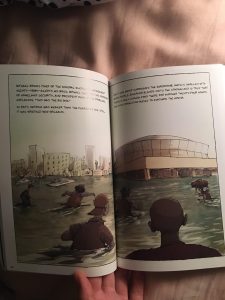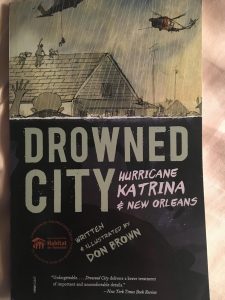

Author: Don Brown
Illustrator: Don Brown
Publisher and Year: Houghton Mifflin Harcourt, 2015
Number of pages: 96
Tags/Themes: Culture, Emotion, Family, Graphic Novel, Non-fiction, 6-8, Olivia Ruff
Genre: Non-fiction
Descriptive Annotation: The novel is about Hurricane Katrina. The novel shows the reasons why the hurricane was disastrous, but it also shows how the country and the communities responded to helping struggling survivors. The students should understand complex words, and drowning is discussed in the novel, so this book would not be ideal for young children for those two reasons.
Classroom Application: This text would be effective in an English or History classroom. The novel is an interesting form that is not that of a traditional novel, so it would be interesting to analyze due to the form. It is important to show students that there is engaging and important literature that strays from the traditional chapter book format. It would be beneficial in a History classroom because the novel covers many different aspects of Hurricane Katrina including involvement at the community level along with federal level. Novels that are creditable and effectively show several aspects of a historical event is something that would be good to use in the classroom in order to offer a different form.
Linguistic and Cultural Diversity Analysis: The novel covers the disaster that struck New Orleans when Hurricane Katrina hit. The novel addresses the struggles that came with the hurricane including the obstacles facing the survivors, leftover environmental concerns plaguing the community, and the response from local and federal governments. This will enlighten younger students who were not alive for the hurricane to better understand the event and all of the different ways survivors struggled in the aftermath. I would assign this novel because of the form, and I would introduce this novel as a way to introduce graphic novels to my class. In terms of content, I would begin class discussion with asking them a question along the lines of, “What can you all tell me about hurricanes? Think of all aspects of the natural disaster.” And then I would put their responses on the board in order to create class discussion, and the novel would go into detail about environmental and social issues involved with one of the most horrific hurricanes to date. The narrative is written in a way that presents many facts, and I will include some quotes: “But the people there decide that being inside is better than staying abandoned on the sidewalk, and break in” (43). “Scores of sick, frail and elderly people swamp emergency medical clinics. Many are still strapped to doors used as makeshift stretchers” (74).
